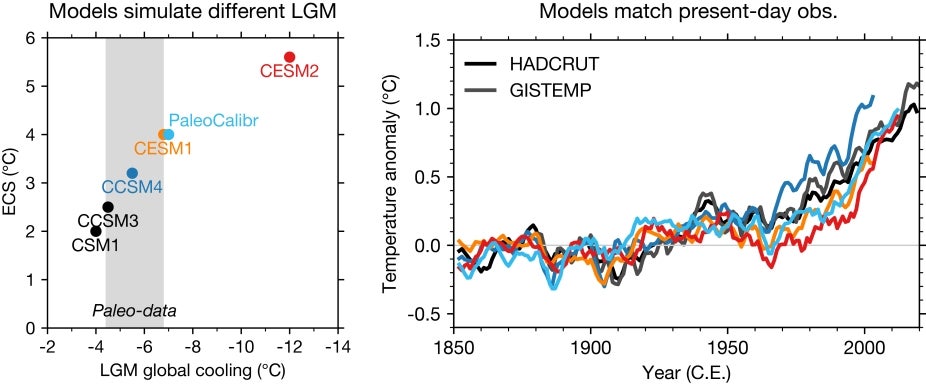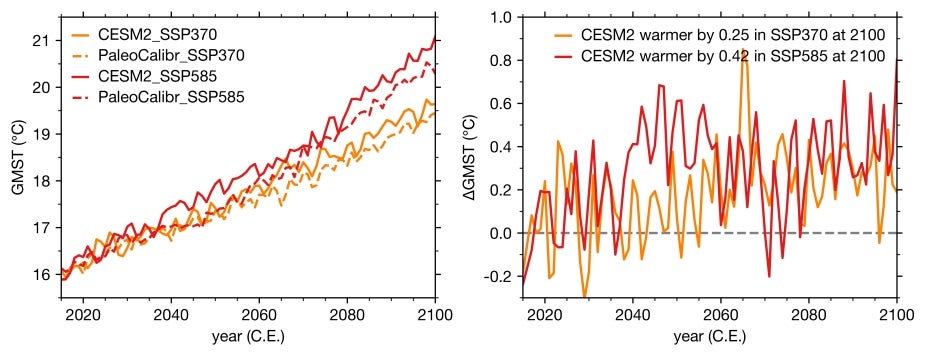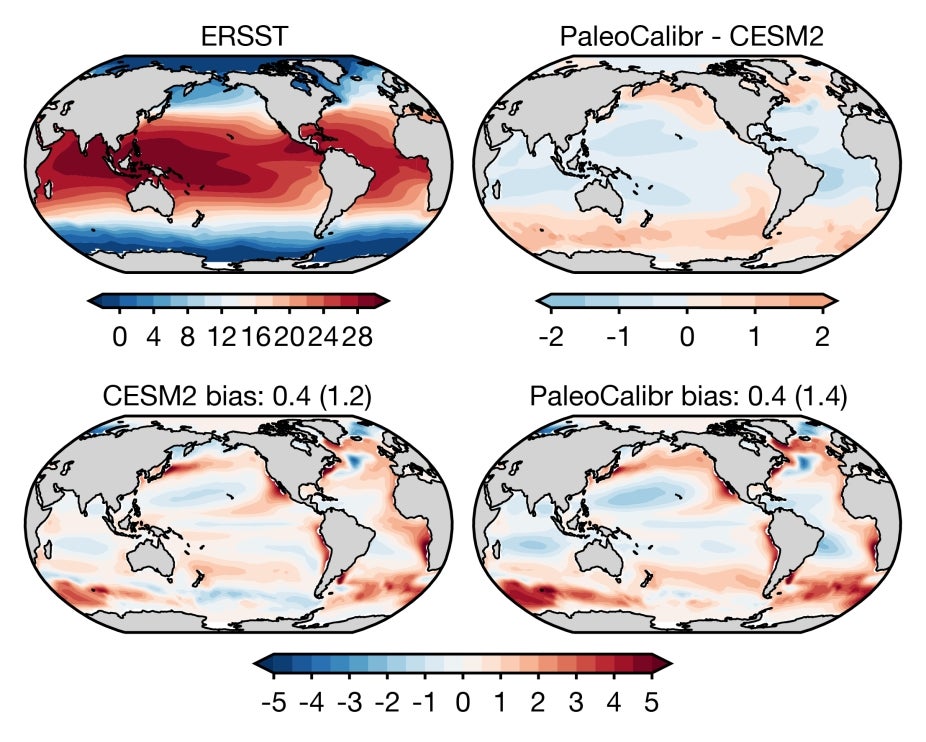The Paleoclimate-Calibrated CESM2 and simulations

Left: LGM global cooling versus ECS in CESM models. LGM data estimation is from Tierney et al. (2020).
Right: Historical warming in CESM models compared with present-day observations.
The Paleoclimate-calibrated CESM2 (PaleoCalibr) was developed to fix issues in the standard CESM2 that led to unrealistically cold simulation of the Last Glacial Maximum (LGM) and high equilibrium climate sensitivity (ECS).
The PaleoCalibr fixes include (1) removing a limiter on the cloud ice number in the microphysics (MG2) to improve the physical consistency of mixed-phase clouds, and (2) shortening the microphysical timestep (substepping in MG2) to improve the numerical performance, i.e., to have a converging solution in the cloud feedback.
With these fixes, PaleoCalibr simulates a much more realistic LGM, a much lower ECS of 4℃ (down from ~6℃ in the standard CESM2 with a ~2° atmosphere), a weaker aerosol-cloud interaction by 20%, and a realistic present-day climate, compared to the standard CESM2.
See the FAQ below if you have questions on PaleoCalibr. Further details and background information can be found in the papers below:
- Zhu, J., Otto-Bliesner, B. L., Brady, E. C., Gettelman, A., Bacmeister, J. T., Neale, R. B., Poulsen, C. J., Shaw, J. K., McGraw, Z. S., & Kay, J. E. (2022). LGM paleoclimate constraints inform cloud parameterizations and equilibrium climate sensitivity in CESM2. Journal of Advances in Modeling Earth Systems, 14(4), e2021MS002776. https://doi.org/10.1029/2021MS002776 [WILEY TOP DOWNLOADED ARTICLE] [WILEY TOP CITED ARTICLE]
- Zhu, J., Otto-Bliesner, B. L., Brady, E. C., Poulsen, C. J., Tierney, J. E., Lofverstrom, M., & DiNezio, P. (2021). Assessment of equilibrium climate sensitivity of the Community Earth System Model version 2 through simulation of the Last Glacial Maximum. Geophysical Research Letters, n/a(n/a), e2020GL091220. https://doi.org/10.1029/2020GL091220
- Zhu, J., Poulsen, C. J., & Otto-Bliesner, B. L. (2020). High climate sensitivity in CMIP6 model not supported by paleoclimate. Nature Climate Change, 10(5), 378–379. https://doi.org/10.1038/s41558-020-0764-6
Please read also a Commentary by Burls and Sagoo (2022).
We kindly ask that you reference the appropriate paper(s) and acknowledge the PaleoclimateWG and computing resources from NSF and NCAR CISL when presenting results based on these simulations in either oral or written form.
Project Details
- Simulation Names:
- LGM: b.e21.B1850.f19_g17.PaleoCalibr.21ka.02
- PI: b.e21.B1850.f19_g17.PaleoCalibr.PI.02
- Abrupt4×CO2: b.e21.B1850.f19_g17.PaleoCalibr.4xCO2.02 & b.e21.B1850.f19_g17.PaleoCalibr.4xCO2_COSP.02 (with satellite simulator)
- Historical: b.e21.BHIST.f19_g17.PaleoCalibr.HIST.02
- SSP370: b.e21.BSSP370cmip6.f19_g17.PaleoCalibr.SSP370.02
- SSP585: b.e21.BSSP585cmip6.f19_g17.PaleoCalibr.SSP585.02
- 1pctCO2: b.e21.B1850.f19_g17.PaleoCalibr.1pctCO2.02
- AMIP: f.e21.FHIST_BGC.f19_f19_mg17.PaleoCalibr.AMIP_COSP.01
- Model Version: CESM2.1-PaleoCalibr
- Resolution: 1.9x2.5_gx1v7 (nominal 2° atmosphere/land and 1° ocean/sea ice)
- Ensemble Size: one
- Time Frequencies Saved: Monthly
- Machine: NWSC Cheyenne
- Compsets: B1850
- PI and PI-based simulations: 1850_CAM60_CLM50%BGC-CROP_CICE_POP2_MOSART_CISM2%NOEVOLVE_WW3
- LGM: 1850_CAM60_CLM50%SP_CICE_POP2_RTM_SGLC_SWAV
Data Acquisition
-
On the NWSC computing storage at:
/glade/campaign/cgd/ppc/jiangzhu/PaleoCalibr
- On ESGF, search with the following keywords:
- Source ID: CESM2-FV2
- Variant Label: r1i2p2f1
- Version: 20220915
Frequently Asked Questions
-
How can I implement the PaleoCalibr fixes in my own simulations with CESM2.1?
Follow steps described in this GitHub repository. Briefly, you need to remove the limiter on cloud ice number in micro_mg2_0.F90 and add microphysical substepping in user_nl_cam, along with other relatively minor tuning and changes.
-
Has PaleoCalibr been tested in CESM2 with a ~1° atmosphere?
PaleoCalibr has been partially tested in the ~1° atmosphere configuration. In a pair of short LGM and PI simulations (unpublished), PaleoCalibr decreases the cloud feedback parameter by 25% (from 0.74 to 0.55 W/m‒2K‒1), which suggest that PaleoCalibr with ~1° atmosphere will have a warmer LGM and a lower ECS than the standard CESM2. It remains to be determined whether microphysical substepping with eight substeps is sufficient to produce converging cloud ice number and the cloud feedback in the 1° model. Also, the PaleoCalibr ~1° configuration has not been finely tuned for the preindustrial climate.
-
How did you decide to use eight substeps in the microphysics?
CAM6 produces unrealistically high values of the cloud ice number after the limiter is removed (see Figure 5 of Zhu et al., 2022). A shorter microphysical timestep (substepping) resolves the problem through decreasing cloud ice number. Our exploration suggests that with eight substeps the model simulated cloud ice number and cloud feedback exhibit a converging solution, i.e., further increase of substepping does not decrease the cloud ice number and the cloud feedback any more (Figures 5 and 6 of Zhu et al., 2022).
-
Does PaleoCalibr produce colder future climate projection than the standard CESM2?
Yes. In a comparable ~2°-atmosphere configuration, the global mean surface temperature (GMST) in PaleoCalibr future projections (SSP370 & SSP585) is colder by ~10% than the standard CESM2 at year 2100. See the plot below.

-
Does PaleoCalibr produce a lower transient climate response (TCR)?
No. TCR is comparable between PaleoCalibr and the standard CESM2 (1.9℃ with the ~2° atmosphere). PaleoCalibr decreases the cloud feedback mostly over the mid-latitudes (Figure 13 of Zhu et al., 2022) and the effects on global temperature emerge at longer time scales (>50 years).

-
Is the present-day climate simulated by PaleoCalibr very different from that by the standard CESM2?
No. The overall skill in simulating the present-day clouds and other mean state variables is comparable between PaleoCalibr and the standard CESM2 (see the Taylor Diagram (Figures 8 and 13) in Zhu et al., 2022). Notably, PaleoCalibr simulates better cloud fraction and phase over the Arctic (Figure 9). We did minimal tuning when developing PaleoCalibr by trying to use the model parameters as close to the standard CESM2 as possible. As a result of this minimal tuning, biases in SST are larger in PaleoCalibr (see the figure on the right with values of the mean bias and root-mean-squared error). These biases could be reduced if we tuned the model differently specifically targeting these biases.
-
Do I need to implement the PaleoCalibr fixes in my simulations?
It depends. PaleoCalibr is recommended if you are studying equilibrium climate sensitivity, strength of the cloud feedback and aerosol-cloud interaction, or a climate state that is subject to large external forcings (for example the LGM features an effective radiative forcing of ~‒6 W/m‒2).
-
Can PaleoCalibr simulate past hothouse climate, like the early Eocene?
No. The standard CESM2 runs away (top-of-model net radiation increases with surface temperature increase) at 4×CO2 under the early Eocene condition. PaleoCalibr improves upon the standard CESM2 but runs away at 6×CO2. The Paleo Group is actively working on a physically justified configuration that can realistically simulate the hothouse climate.
-
Does PaleoCalibr slow down the model?
Yes. Microphysical substepping adds model costs by ~20% and slows down the model throughput by 20% (last tested on Cheyenne with eight MG2 substeps).
Diagnostics:
| Simulation | ||||||
| b.e21.B1850.f19_g17.PaleoCalibr.PI.02 | atm ‒ obs. | atm ‒ control | ocn | lnd | ice | cvdp |
| b.e21.B1850.f19_g17.PaleoCalibr.21ka.02 | N/A | atm ‒ control | ocn | lnd | ice | N/A |
| f.e21.FHIST_BGC.f19_f19_mg17.PaleoCalibr.AMIP_COSP.01 | atm ‒ obs. | atm ‒ control |